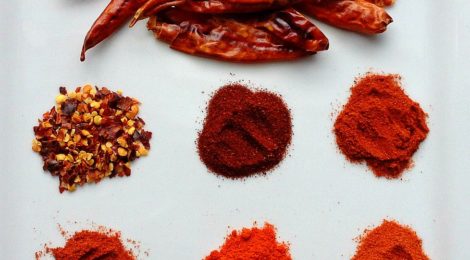
SPICE SPOTLIGHT: RED CHILLI PEPPER
What is red chilli pepper?
Red chilli pepper is the fruit of the plant of the capsicum, which are members of the ‘nightshade family‘ — other common nightshade vegetables include bell peppers and eggplant. According to “The Spice Bible” there are five main species of chilli plants and well over 300 different subspecies of chilli that vary in size, shape, color, flavor and degree of hotness. The most common varieties of dried chilli peppers include ancho, bird’s eye, cascabel, chipotle, common (a loose term often used to describe the 2.5-inch dried, long red chilies), habanero, mulato, new mexico and pasilla. Despite the variety, they all descend from the same chillies indigenous to South America.
“Wait, when I think of Indian cuisine I picture spicy, hot dishes that have a lot of red chilli pepper — didn’t it originate in India?”
Nope. Although chilli pepper is probably the spice most associated with Indian food, as dishes all across India use fresh, dried, ground, or powdered chillies, according to a terrific book Curry: A Tale of Cooks and Conquerors, it was the Portuguese who first encountered red chilli peppers in South America and brought them to India at the beginning of the 15th century. Until then, nobody in India had seen a red chilli pepper! Prior to this, Indians used long green chillies and black pepper to add heat to dishes. Today, India is the world’s largest producer, consumer and exporter of red chilli pepper.
What does red chilli pepper look like?
Red chilli pepper is mostly red to dark reddish-brown and has yellow seeds. It can be bought fresh, dried, whole, crushed, or powdered. Here are a few varieties I have in my kitchen:

Different red chilli peppers found in my kitchen: starting from the top, going left to right: whole dry red chillies, crushed red pepper, ancho chile powder, paprika, basic hot chilli powder, kashmiri red chilli powder, ground cayenne powder
The most commonly used variety is crushed red pepper, pictured here, is mostly red with specks of yellow resulting from the mix of red chilli peppers used in its production. While many chilli peppers, such as cayenne and bell peppers, are deep red in color, ancho peppers – which are actually dried poblano peppers – are almost black. The specks of yellow come from the seeds of the whole chillies.
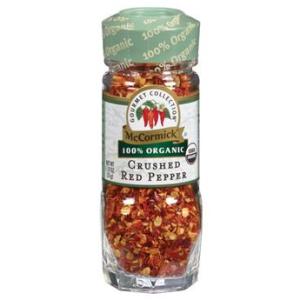
Crushed red pepper is a popular condiment around the world to add extra heat to any dish – from Italian pizza joints to Chinese red pepper flakes in oil
What does red chilli pepper taste like?
Red chilli pepper is hot and spicy and lends heat to any dish, primarily attributable to the seeds. Chilli peppers vary in degree of hotness. The Scoville scale is often used to measure the level of heat in chilli peppers based on the amount of capsaicin present (the active component of chilli peppers), and ranges from 0 (bell pepper) to 16,000,000 (pure capsaicin). Until recently, my husband Sean was convinced (after reading a number of articles on it) that India’s Ghost Pepper (Bhut Jolokia) was the world’s hottest chilli pepper; however, in 2011 the Trinidad Moruga Scorpion took the #1 spot. Then, in 2012 the Ghost Pepper again reclaimed the #1 spot, pulling ahead of its rival; but now it appears that they’re tied, both coming in at more than 2 million Scoville units. It’s a battle royale for the world’s hottest red chilli pepper!
Commonly used crushed red pepper can be made from a variety of dried red chilli peppers, most often from a combination of dried ancho, bell and cayenne peppers. While red chilli flakes are made up of ancho, cayenne and bell peppers, the high heat level comes from the cayenne peppers which have a rating of 30,000-50,000 Scoville units. In Indian food, crushed red pepper OR red chilli flakes lends direct heat to a dish – the precise amount of red chilli flakes used depends on your tolerance for heat. If you’re interested in how different spices flavor an Indian dish, read more on the 6 Key Elements of Taste in Indian Cuisine.
How can I use red chilli in cooking?
In contemporary Indian cooking, two main kinds of chillies are used: green chillies that are used fresh and red chillies that are used dried. According to 50 Great Curries of India, there are so many varieties of these two chillies that differ in length and level of heat — so when you’re cooking, it’s all relative when it comes to the amount you should use, and recipes will indicate how much depending on the type of dish and the region it comes from.
Chillies are a good source of Vitamin C, help digestion (although that may seem counterintuitive), and were used for medicinal purposes by Ayurvedic physicians and the ancient Greeks and Romans. Many Europeans believed that spices possessed magical powers. According to Curry: A Tale of Cooks and Conquerors, by the 15th century, virtually every European recipe contained spices of some sort and “pepper was the king of spices and the apothecary of an affluent medieval household would have always had some in store, while in the kitchen the cooks would have kept some ready-ground, close to hand in a special leather pouch. It was the one spice that seem to have been used by medieval people on almost all levels of the social scale.”
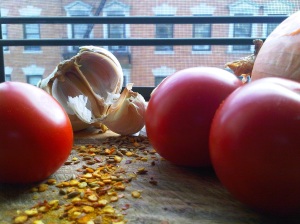
Crushed red pepper or red chilli flakes are a key ingredient in a basic Indian curry, lending a slight hint of heat to round out the balance of flavors
How can you use it in your cooking? Red chilli pepper can be used as a seasoning or a condiment. Most of you might have a small bottle of ground cayenne powder or crushed red pepper or red chilli flakes in your cupboard. Today, red chilli is used in a variety of cuisines — think of the crushed red pepper on tables in Italian restaurants and pizza parlors alongside salt, black pepper, and parmesan cheese.
Which Big Apple Curry recipes feature red chilli pepper?
Red chilli flakes can be used in countless Indian dishes — here are a few suggestions:
South Indian-style Tomato Rice Soup
Coconut Curry Chicken Wings
Autumn Lentil Curry
The 5-10-5 Rule
To make a variety of authentic Indian dishes at home, you need a few key things in your pantry and fridge. In the course of teaching my husband Sean the basics of Indian cooking, I created The 5-10-5 Rule – a useful cheat sheet on the main aromatics, ground spices, whole spices, and herbs you need in your kitchen. Of course, red chilli is one of the key 10 spices.

10 key ground spices for Indian cooking — starting from top left to right: cumin, coriander, sugar, curry powder, paprika, salt/pepper, garam masala, turmeric, and red chilli flakes
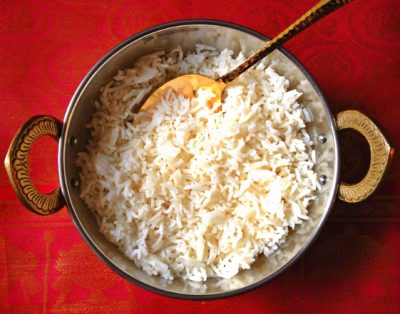


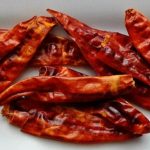
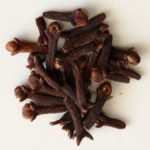
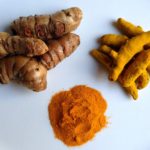
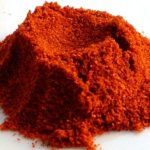
I love spices, I have almost all the spices you have mentioned 🙂
Dear Joy! Great to hear it — you can make a variety of Indian dishes if you already have most of the spices, including most of the recipes on this blog!